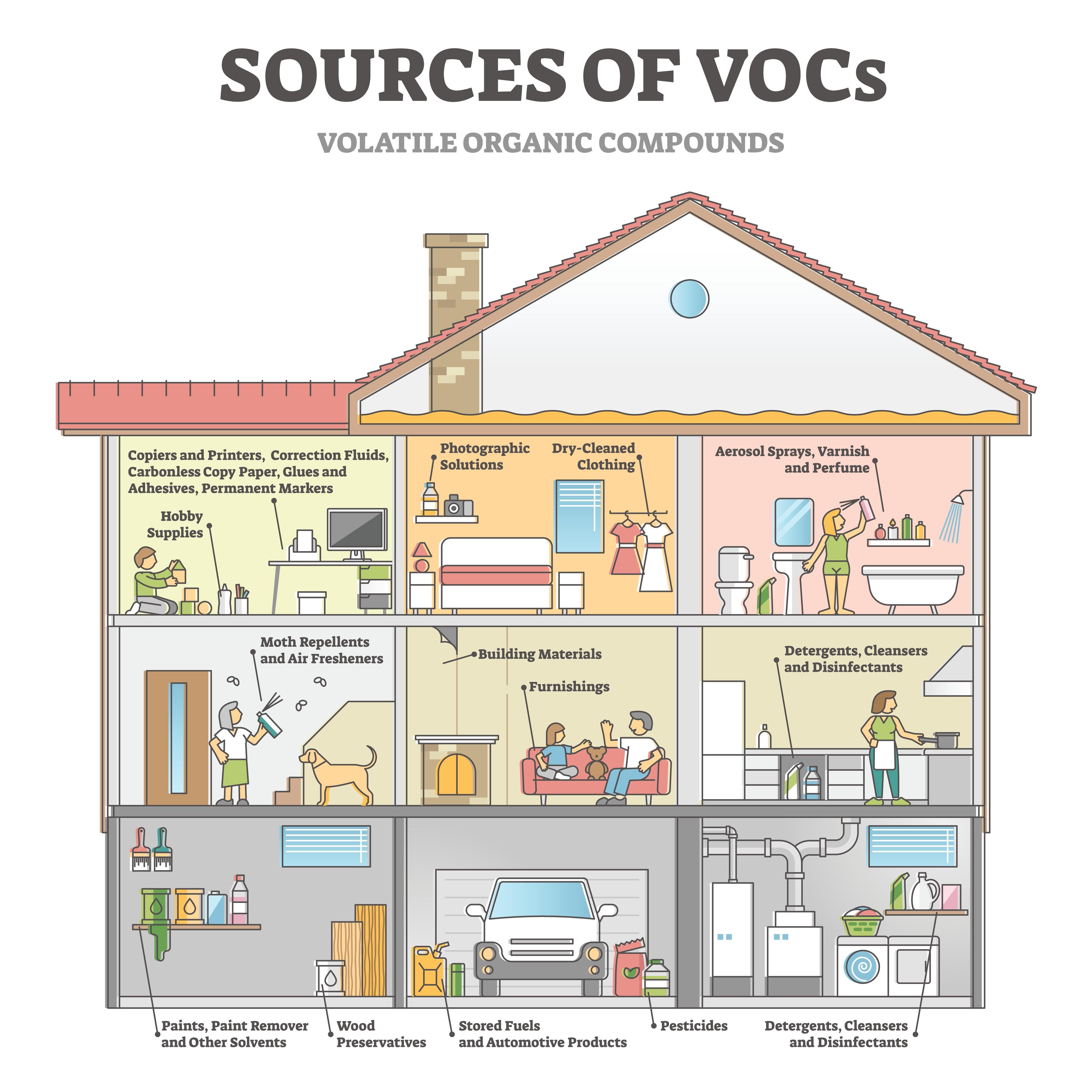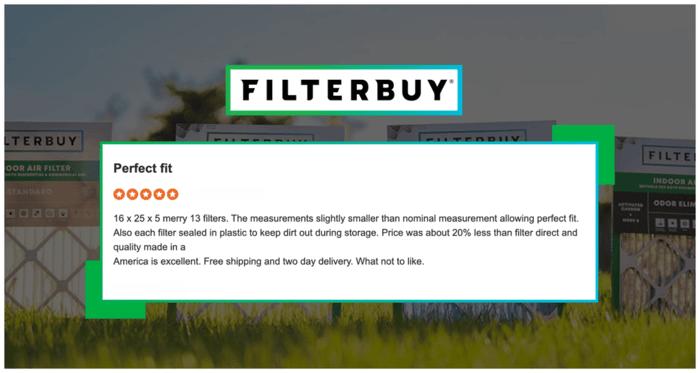Shop by

Ever encountered headaches or even health concerns and wondered why? Volatile Organic Compounds (VOCs) could be the reason. Hidden in ordinary household items, they can silently impact your health and well-being. But don't fret; your HVAC system actually is your indoor superhero simply because its job is to eliminate these substances from your living spaces.
So, ensure regular maintenance of your HVAC unit for optimum efficiency. You can start with changing filters every 60-90 days. Then, check your coils and fins routinely—these actions will help your system in its fight.
We already know that household supplies are known to contain VOCs. But it does not end there. Materials used for buildings, furnishings, copiers, printers, and even activities such as cooking and smoking also contribute to indoor emissions of said substances.
Poor indoor air quality results from its high concentrations, potentially leading to health problems. Monitoring and controlling its levels in our surroundings is necessary, especially within indoor environments. Methods to reduce its levels include efficient ventilation systems and air purifiers, which you can all find at Filterbuy. Make sure to partner it with regular upkeep of heating, ventilation, and air conditioning (HVAC) units to promote better air quality and unit efficiency.

Symptoms of exposure are often subtle initially, yet neglecting them may result in severe issues in the future. Brief exposure may cause mild symptoms. But they actually serve as the body's early warning signs against exposure.
On the other hand, exposure over a long period has more serious health consequences. Extended and repeated exposure may cause damage to your organs. Some types of these substances are found to be carcinogens, which could cause the formation of cancer cells.
That’s why it is important to have knowledge about these substances and their potential effects. As it can be your first step towards ensuring a safer, healthier living environment.

We now know that these substances come from diverse sources that we often see and use at home. And we also realize that these substances pose a serious threat to indoor air quality. Plus, health issues arise from long-term exposure, which means it is time to check for efficient solutions to solve this problem.
HVAC (heating, ventilation, and air conditioning) units are emerging as an effective solution against this harmful substance. They show considerable potential in enhancing air quality and reducing concentration levels.
Remember, these systems also function by circulating air indoors. During this cycle, these systems filter the air, eliminating harmful airborne particles. As a result, air quality improves, creating healthier indoor environments emptying it of such toxic compounds.
Nonetheless, HVAC units' success in eliminating these substances heavily relies on their upkeep and application. Maintenance steps such as replacing filters regularly, proper ventilation, placing plants with air purifying capabilities, and usage of materials with lower concentrations of VOCs prove powerful against these components.
When properly maintained, HVAC systems greatly affect indoor air quality. Such units, when serviced regularly, significantly lower the concentration of harmful particles. Indeed, the system's proficiency in reducing VOCs is directly linked to its maintenance level.
Furthermore, HVAC systems that receive regular maintenance often have longer operational lives, providing superior air quality for extended periods. Routine checks ensure that components like custom air filters, coils, and fins are in top condition, allowing for effective harmful airborne particle removal from indoor air.
Regular maintenance of your HVAC system aids in combating indoor pollution, including Volatile Organic Compounds. Such maintenance leads to cleaner air and a decreased concentration of these compounds in your living space.
Replacing filters is a crucial maintenance task. Keep in mind that they capture microscopic airborne particles, including this harmful compound. After prolonged use, it is normal for filters to become less efficient, allowing these particles to circulate in your living space. So, every 90 days is the recommended interval for filter replacement. But homes with many pets or occupants with allergies should consider doing so every 60 days.
Last but not least, integrating an air purifier into your unit is another beneficial step. Specifically, air purifiers that utilize activated carbon filters excel at capturing these harmful airborne elements. Devices like these not only offer cleaner air but also extend the operational life of your equipment by decreasing the burden on the filters.
Yes, air purifiers with activated carbon filters can effectively remove many VOCs from the air. However, the specific VOCs removed and the puriefier's effectiveness depend on the filter type and the concentration of pollutants.
Adding indoor plants like spider plants, Boston ferns, and peace lilies can naturally absorb these compounds and improve air quality. Enhancing ventilation is another effective way to lower their levels. For better results, open windows, use exhaust fans and consider a whole-house ventilation system.
The time it takes to air out VOCs depends on several factors, including:
While vacuuming can help remove dust and other particles that may contain VOCs, it doesn't directly remove them. However, using a HEPA filter vacuum can capture smaller particles carrying VOCs.
To flush out VOCs, you can open windows and doors, use an air purifier with activated carbon filters, and reduce sources of VOCs. Also, ventilate your home by opening windows and doors to lower their levels with fresh air.
Try different methods to speed up VOC off-gassing. Increase ventilation to push VOCs out and bring fresh air in. Open windows, turn on exhaust fans, or create cross-ventilation in kitchens and bathrooms.
VOC levels can increase at night due to cooler temperatures and higher humidity, which can slow down the rate of VOC evaporation and dispersion.
Vinegar cleaning helps control VOC levels in the air. The acetic acid in vinegar neutralizes some VOCs, lowering their concentration indoors. This reaction produces less harmful byproducts, making it an effective solution.
The first strategy involves using indoor plants. Many types of indoor plants act as natural air purifiers by absorbing harmful chemicals and releasing oxygen. The second strategy involves using ventilation systems. Proper ventilation significantly reduces the concentration of VOCs in indoor spaces. Lastly, reducing the use of VOC-emitting products is another effective method.
Efficient systems with high-quality HVAC filters effectively remove these compounds, improving overall air quality. Regular HVAC filter maintenance and duct cleaning are essential, as accumulated dust and debris hinder air circulation and reduce the system's effectiveness.
For individuals with prolonged exposure, recovery can be a lengthy process requiring persistent management and monitoring. Regular follow-ups are crucial to track progress and adjust treatment plans as necessary. Occupational therapists can also play a critical role in recovery, providing strategies to minimize VOC exposure in daily activities. While recovery can be challenging, it is achievable with focused and comprehensive care.
The duration of VOCs in a room depends on factors such as the source strength, ventilation rate, and temperature and humidity.
